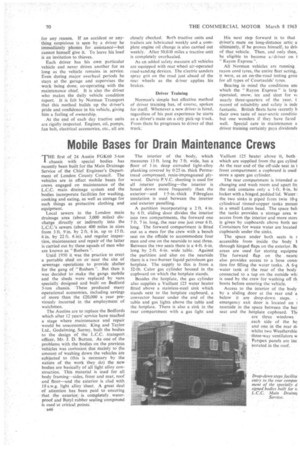Mobile Bases for Drain Maintenance Crews
Page 72

If you've noticed an error in this article please click here to report it so we can fix it.
'THE first of 24 Austin FGK60 3-ton I. chassis with special bodies has recently been built for the Main Drainage Service of the Chief Engineer's Department of London County Council. The vehicles are in effect mobile bases for crews engaged on maintenance of the L.C.C. main drainage system and the bodies incorporate facilities for washing, cooking and eating, as well as storage for such things as protective clothing and equipment.
Local sewers in the London main drainage area (about 3,000 miles) discharge directly or indirectly into the L.C.C.'s sewers (about 400 miles in sizes from 3 ft. 9 in. by 2 ft. 6 in. up to 15 ft. 6 in. by 22 ft. 6 in), and regular inspection, maintenance and repair of the latter is carried out by these squads of men who are known as " flushers ".
Until 1950 it was the practice to erect a portable shed on or near the site of sewerage operations to provide shelter for the gang of " flushers ". But then it was decided to make the gangs mobile and the sheds were replaced by vans specially designed and built on Bedford 3-ton chassis: These produced many operational economies, including savings of more than the £20,000 a year previously incurred in the employment of watchmen.
The Austins are to replace the Bedfords which after 12 years' service have reached a stage where maintenance and repair would be uneconomic. King and Taylor Ltd., Godalming, Surrey, built the bodies to the design of the L.C.C. transport officer, Mr. J. D. Burton. As one of the problems with the bodies on the previous vehicles was corrosion dud mainly to the amount of Washing down the vehicles are subjected to (this is necessary by the nature of the work they do) the new bodies are basically of all light alloy construction. This material is Used for all body framing—sides, front and rear, roof and floor—and the exterior is clad with 18 s.w.g. light alloy 'sheet. A great deal of attention has been paid to ensuring that. the exterior is completely waterproof and Butyl rubber sealing compOund is used 'at critical. points.
B46
The interior of the . body,which measures 13 ft. long by 7 ft. wide, has a floor of I in. deep extruded light-alloy planking covered by 0-25 in. thick Penn atread compressed, resin-impregnated plywood. Darvic P.V.C. sheeting is used for all interior panelling—the interior is hosed down more frequently than the exterior—and 1-5-in.-thick Fibreglass insulation is used between the interior and exterior panelling.
A partition incorporating 'a 2 ft. 4 in. by 6 ft. sliding door divides the interior into two compartments, the forward one 7 ft. 7 in. long, the rear one just over 6 ft. long. The forward compartment is fitted Out as a mess for the crew with a bench seat on the offside to accommodate four men and one on the nearside to seat three. Between the two seats there is a 4-ft. 6-in. long by 2-ft. 6-in, wide table. Against the partition and also on the nearside there is a two-burner liquid petroleum gas hotplate. The supply to this is from a 32-lb. Calor gas cylinder housed in tbe cupboard on which the hotplate stands.
Besides the hotplate, the gas cylinder also supplies a Valliant 125 water heater fitted above a stainless-steel sink which stands next to the hotplate cupboard, a convector heater under the end of the table and gas lights above the table and the hotplate. There is also a sink in the rear compartment with a gas light and Vaillant 125 heater aboveit, both which are supplied from the gas cylind At the rear end of the off-side seat in front compartment a cupboard is used store a spare gas cylinder.
The rear compartment is intended w changing and wash room and apart fn the sink contains only a l-ft. 8-in, hi locker with a hinged, padded lid. Water1 the two sinks is piped from twin 101 cylindrical tinned-copper tanks mounl in a small Luton head. 'The space bell the tanks provides a storage area w access from the interior and more ston is given 'by cupboards above both se Containers for waste water are located
cupboards under the sinks. .
The space under both seats is t accessible from inside the body t through hinged flaps on the exterior. 13( areas are used for storing equipme -The forward flap'. on the . nears] also provides access to a hose corn!, tion for filling the water tanks. A 6-g 'water tank at the rear of the body connected to a tap on the outside whi is used by the crew for washing off th boots before entering the 'vehicle.
Access to the interior .of the body by a sliding door at the rear end a below it are drop-down steps. , emergency exit door is located on nearside in the space between the ber seat and the hotplate cupboard. Thl are three windows each sideof the bc and one in the rear dc whilst two Weathershie three-way ventilators w Perspex panels are inc .porated in the roof.




















































































































